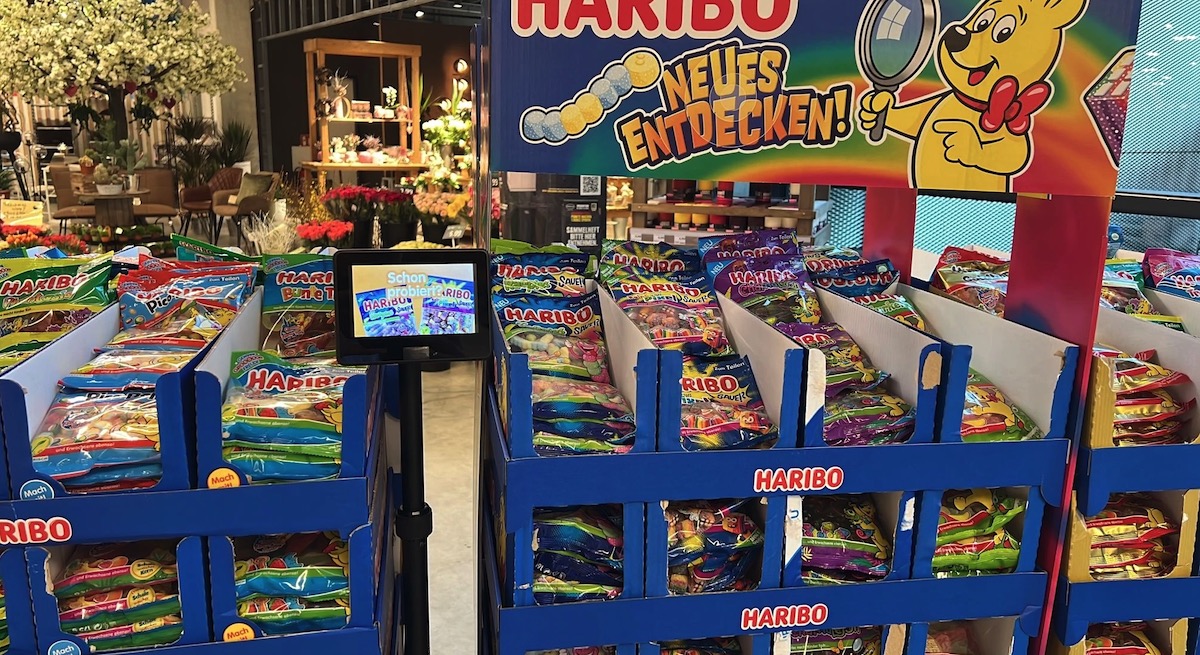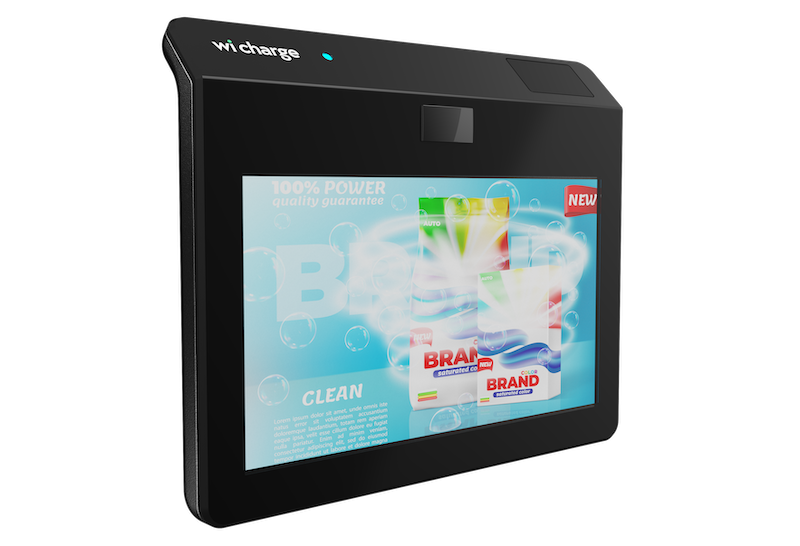
Wi-Charge’s Cord-Cutting Gen 3 Wireless Shelf-Edge Retail Screens Are Sleeker, Offer More Features
February 20, 2024 by Dave Haynes
The Israeli firm Wi-Charge has launched a third-generation of its retail-focused wireless video displays – small 5 and 7-inch units meant mount at the front of in-aisle shelves and with end-caps.
The display units are skinny LCDs that can easily be mounted and moved around as needed, since they don’t rely on wiring – regular electrical or power-over-ethernet (POE) – run in the shelving systems. They get their power over the air, so to speak, from Wi-Charge’s patented wireless power transmitter system.
The third-gen loses some of the bulk of earlier units, and has a sleeker, angular design that perhaps fits better in retail fixtures. There is a clamp system that allows store merchandisers to quickly release, move and lock in place the screens as needed.

The value proposition is that wireless displays don’t require what can be very high materials and labor costs to get power to positions on shelves, and even if that is done, the fully wireless nature of these things is they can can shift as needed, without unplugging, running extension cords or other work needed to get screens up and on in a different place.
The Wi-Spot displays just need to be in range of the transmitter. The receiving displays convert optical beams from the transmitter to power.
The other selling argument is that in-store retail media networks that have screens as part of the mix tend to usually have screens in fixed positions that never change, so they can address foot traffic for a tiny fraction of a large footprint store. With portable, wireless-powered displays, the rest of the store can be covered, as needed.
Wi-Charge says its video displays “are being installed at a growing number of retailers in the United States, Europe, Asia, and South America, and the new generation Wi-Spot 3.0 will be broadly available globally beginning in May.”
The attraction to retailers and brands is sales lift. I have seen and heard all kinds of stories through the years, about other in-aisle display efforts, enough to buy into Wi-Charge’s assertion that “Wi-Spot devices consistently outperform in sell-through compared to similar products in the same category, generating, on average, a three-to-four times sales lift compared to similar products not promoted with Wi-Spot. “
Though this is quite well-established that marketing at the point of decision is powerful, these kinds of screens aren’t everywhere because of their capital costs and the practicalities of working with them. Earlier attempts at this sort of thing have included battery-operated displays, but batteries need to maintained and re-charged. I’ve been in meetings with brands and their marketing agencies going back 15+ years in which there was awareness of positive sales lift and interest in tapping into that, but great reluctance to buy the hardware and do the needed infrastructure work.
This video from an Edeka grocery store in Germany gets into how they work …
From PR:
85% of purchases take place on store shelves, but only 1% of marketing budgets are targeted there due to the limitations of current technologies. It is a prohibitively expensive and time-intensive process for retailers to install electric outlets on store shelves or endcaps to power video displays. For example, if a typical large retailer wanted to install five video displays in each of its stores, it would cost an estimated minimum of $10 million on installation alone.
Despite these high costs, in-store video displays are growing fast, driven by retail media networks (RMNs), and they remain a high priority for retailers. Video displays provide an ideal way to drive high-margin advertisements and incremental revenue for brands by creating product interest, excitement, and loyalty.
Wi-Charge’s breakthrough and patented infrared wireless electricity technology eliminates the significant cost and complexity of installing in-store video marketing platforms by safely and efficiently delivering electric power over the air to the Wi-Spot video displays to provide constant and reliable power without wires. Since the displays are powered wirelessly, they are easy to move throughout the store and create a wide range of opportunities for retailers to generate revenue in more places in the store.
The Wi-Spot 3.0 includes a suite of backend data and analytics that provide retailers with vital metrics about the performance of the video displays in stores, including the number of impressions per day, by aisle, and by store. This unique analytics dashboard gives brands and retailers unprecedented insights into customer traffic and the exposure of marketing messages every day. This brings web-level analytics to a physical environment, the holy grail for in-store marketing.
“Retail media networks are the fastest growing space in the history of the advertising market. Until now, it was mainly focused online, yet today, there’s a huge thirst to tap into the enormous opportunity of high-margin, in-store ad space. To do that, a critical technology piece has been missing, and it is getting power to the shelves easily and at low cost,” says Ori Mor, co-founder and chief business officer of Wi-Charge. “Wi-Spot video displays are the first technology to deliver an easy and inexpensive way for retailers to deliver compelling content to consumers while they shop. Our initial customers have experienced up to a 3x increase in in-store sales for specific products when they deploy Wi-Spots while supporting ESG and sustainability initiatives. We have just begun to work with retailers to unleash the full potential of digital in-store marketing.”
I had a PR briefing last week, ahead of the release, with Mor.
I wondered why his company was not selling displays, and not staying focused on the transmitter technology. They’d like to, Mor says, but in order to show the marketplace what this is all about, somebody needs to lead the way and get product in the field. He would love to license the technology to other companies that specialize in small, shelf-edge displays, like Bluefin and Mimo. But for now, Wi-Charge needs to be manufacturers to get the concept in the field, demonstrate to potential partners that there is indeed an addressable market, and speed up adoption.
I asked about retail being a focus, and he says retail has a genuine problem with power availability, especially in older-build stores but even in newly-opened ones that never anticipated needed power in the fixturing. Retail, he says, also offers scale.
I wondered, as well, if there is any reluctance out there about the safety of wireless power, and Mor says there has been zero pushback.
Mor didn’t want to get into unit prices for the combined display and transmitter solution, because of the variables of things like opportunity size, but he says a good rule of thumb is these things pay for themselves in less than six months. The official line is: “Wi-Spot’s are priced at a few tens of dollars per month or a one-time fee of a few hundred dollars, depending on the customer’s preference.“
And finally, I asked if 7-inches maxes out the capabilities for the transmitters. No, he says, they’re working on nine and 10-inch units. But he notes, and he’s right, that retailers and brands don’t want big displays in the planogram areas, as big screens rob visual space from product, and make it hard to lift items off shelves if they have to be manipulated around a screen. So while the transmitters are not sending enough power to drive a 40-inch screen, retailers and brands don’t want that anyway.
I did a podcast with Mor in Sept. 2022 that gets into the technology and safety …
And here’s a video of what is involved technically …



Leave a comment